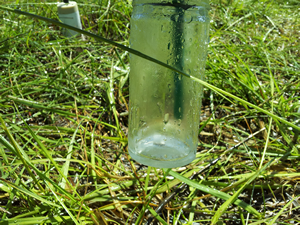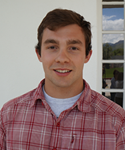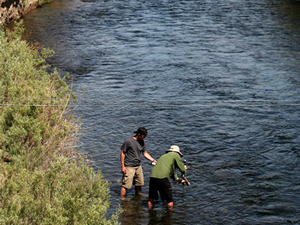iUTAH Undergraduate iFellows
Week 4 Recap
June 9-13, 2014
Allison Albert
 This week I focused on figuring out how the water sampling apparatuses (lysimeters*) need to be set up, and getting all of the parts necessary, as well as making lids for the water collection bottles. Additionally, I read literature about onsite soil water extraction, the types of extraction methods there are, and what can be tested with each different extractor.
This week I focused on figuring out how the water sampling apparatuses (lysimeters*) need to be set up, and getting all of the parts necessary, as well as making lids for the water collection bottles. Additionally, I read literature about onsite soil water extraction, the types of extraction methods there are, and what can be tested with each different extractor.
*Lysimeters are pore water samplers that collect water by vacuuming the air out of the apparatus and drawing the water into the porous cup. The 1 inch diameter lysimeter lacks a shaft to store the water, so it must be connected to a jar to collect the water sample.

The 1 inch diameter lysimeter's collection jar- the collection of water at the bottom of the jar verifies the apparatus is working.
Tim Beach

This week was spent doing field work in Nevada. A group of five of us packed up and headed out Monday morning from USU to the Walker River, located southeast of Reno, Nevada. We deployed almost a full kilometer of a DTS (Distributed Temperature Sensing) cable in a section of the Walker River, along with using thermal imaging, small temperature loggers, and field probes to better understand patterns of differing temperatures within the river. Our goal was to get a better understanding of how agricultural discharge is affecting water temperature in the Walker River, a river that was previously abundant with Lahontan Cutthroat Trout.
I learned a lot about field work- what long days working in a river are like, how often to apply mosquito spray, how to prepare for long-term camping, how to untangle a long cable in a river, adjusting our schedule around wildlife that bite through fiber-optic cables, understanding how devoted black horse flies are to attacking your legs, and most importantly how to develop effective methods for conducting scientific research. I had the opportunity to learn from some awesome graduate students and professors, making this a turning point in my academic career.
Toby Brotherton

Andrew Butterfield
 This week, I spent two days navigating the Cache Valley to help with the annual tap water survey. We visited many local waterways and businesses to collect small vials of water for isotope analysis, which will give insight into the various water sources the valley pulls from. Friday was a big day; my faculty mentor, Michelle Baker, my graduate mentor, Julie Kelso, and I sat down to hash out my research project for the summer. I will be analyzing the effect that UV light exposure has on dissolved organic matter. Using water samples from the Jordan River, I will try to closely model real exposure to the sun over the anticipated travel time from Utah Lake to Farmington Bay, and analyze the effects this exposure has on the dissolved organic matter structure and concentration.
This week, I spent two days navigating the Cache Valley to help with the annual tap water survey. We visited many local waterways and businesses to collect small vials of water for isotope analysis, which will give insight into the various water sources the valley pulls from. Friday was a big day; my faculty mentor, Michelle Baker, my graduate mentor, Julie Kelso, and I sat down to hash out my research project for the summer. I will be analyzing the effect that UV light exposure has on dissolved organic matter. Using water samples from the Jordan River, I will try to closely model real exposure to the sun over the anticipated travel time from Utah Lake to Farmington Bay, and analyze the effects this exposure has on the dissolved organic matter structure and concentration.
Kenyon Gentry
 The pitfall and combination traps were completed and have been deployed: one set at the Marriott library (excluding a combination trap because there are beehives) and one set at the natural history museum, both in Salt Lake City. The combination trap set on top of the museum blew over during the night, so another means of anchoring it to the ground will have to be devised.
The pitfall and combination traps were completed and have been deployed: one set at the Marriott library (excluding a combination trap because there are beehives) and one set at the natural history museum, both in Salt Lake City. The combination trap set on top of the museum blew over during the night, so another means of anchoring it to the ground will have to be devised.
Adam Henrie
 This week, I spent time administering our water resources survey at various locations including Liberty Park, the Gateway Mall, and Ogden trailheads. Administering surveys in person was somewhat difficult, but it proved to be a learning experience by giving me insight into different survey methodologies and their corresponding advantages and disadvantages.
This week, I spent time administering our water resources survey at various locations including Liberty Park, the Gateway Mall, and Ogden trailheads. Administering surveys in person was somewhat difficult, but it proved to be a learning experience by giving me insight into different survey methodologies and their corresponding advantages and disadvantages.
Katy Hicks
 Week 4 was spent coding articles from the Salt Lake Tribune for March and April of 2012, pulling articles from the Logan Herald Journal for 2012, and working on some literature reviews.
Week 4 was spent coding articles from the Salt Lake Tribune for March and April of 2012, pulling articles from the Logan Herald Journal for 2012, and working on some literature reviews.
Alexis Holzwarth
 Week four was an interesting learning experience. I was self directed and endured the mental battle of construction on the roof of the building I work in. I got to experience cubicle life in all its glory. Without guidance, I was venturing into the world of literature in search of information to begin writing about how plant diversity effects urban water use in arid regions. This task proved to be much more difficult than expected and still continues to challenge me. Many hours of reading will hopefully lead to an informed and valuable document. This is just one contribution to metropolitan water research, but it will hopefully be a valued contribution.
Week four was an interesting learning experience. I was self directed and endured the mental battle of construction on the roof of the building I work in. I got to experience cubicle life in all its glory. Without guidance, I was venturing into the world of literature in search of information to begin writing about how plant diversity effects urban water use in arid regions. This task proved to be much more difficult than expected and still continues to challenge me. Many hours of reading will hopefully lead to an informed and valuable document. This is just one contribution to metropolitan water research, but it will hopefully be a valued contribution.
Jeffery D. Josephson

Claire O'Donnell
 This week focused on getting my research project ready. On Tuesday, I presented my concept to Diane Pataki in the morning and later that afternoon to our literature group. The goal of my research project is to investigate how nurseries influence the plants we find in residential yards. Later in the week I went to nurseries to inventory the plants they had available. We also finished mailing our surveys this week. For the fertilizer project, I collected biomass, grass clippings, and soil cores.
This week focused on getting my research project ready. On Tuesday, I presented my concept to Diane Pataki in the morning and later that afternoon to our literature group. The goal of my research project is to investigate how nurseries influence the plants we find in residential yards. Later in the week I went to nurseries to inventory the plants they had available. We also finished mailing our surveys this week. For the fertilizer project, I collected biomass, grass clippings, and soil cores.
Samuel Stout
 We are trying to set up a coding system in which we can rate all of the water conservation reports and general plans for the twelve cities that we are surveying. The goal is to be able to use the coding so we can dissect each city’s plan and find out which cities are more keen on water conservation and which ones are not as much. We are trying to see if there is a correlation between population and attitude in water conservation.
We are trying to set up a coding system in which we can rate all of the water conservation reports and general plans for the twelve cities that we are surveying. The goal is to be able to use the coding so we can dissect each city’s plan and find out which cities are more keen on water conservation and which ones are not as much. We are trying to see if there is a correlation between population and attitude in water conservation.
Anne Thomas
 This was an exciting week: I created a stratified map for my tree survey on ArcGIS, a new thing for me, which allowed me to generate random locations to sample trees in Heber City and Midway. After working out all the details, I got started with the actual survey, and have my first data sheet filled out!
This was an exciting week: I created a stratified map for my tree survey on ArcGIS, a new thing for me, which allowed me to generate random locations to sample trees in Heber City and Midway. After working out all the details, I got started with the actual survey, and have my first data sheet filled out!
Michelle-Kei Williams
 This fourth week, I worked in the chemistry lab quite a bit, analyzing several different sample sets from the storm site. Some were analyzed for just their ammonia and nitrate levels, while others included nitrite and total nitrogen levels as well. I’ve also been working on the literature reviews assigned to me by Pratibha, one of the graduate students I’ve been assisting. Also, because of the extensive knowledge needed to understand the research I’m working on, I’ve been thoroughly engaged in learning any & all relevant background information I can.
This fourth week, I worked in the chemistry lab quite a bit, analyzing several different sample sets from the storm site. Some were analyzed for just their ammonia and nitrate levels, while others included nitrite and total nitrogen levels as well. I’ve also been working on the literature reviews assigned to me by Pratibha, one of the graduate students I’ve been assisting. Also, because of the extensive knowledge needed to understand the research I’m working on, I’ve been thoroughly engaged in learning any & all relevant background information I can.







